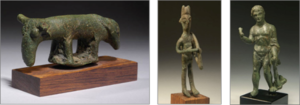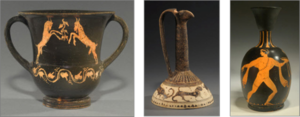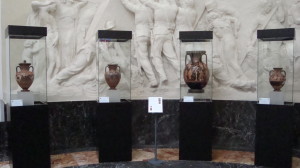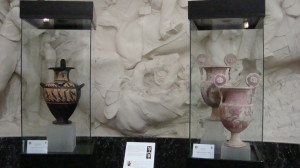by Amineddoleh & Associates LLC | Aug 23, 2020 |
 Last week, Amineddoleh & Associates LLC filed its second Motion to Dismiss in the case of Safani Gallery, Inc. v. The Italian Republic, Civil No. 19-10507 (SDNY), responding to Plaintiff’s Amended Complaint. Here, Plaintiff – an antiquities gallery –seeks redress from Italy for the seizure of a marble antiquity depicting a male bust. The seizure was made by the Manhattan District Attorney, not the Mediterranean republic. The object first gained public attention in 2018 when it was reported by the NY Times that the Manhattan DA seized the object described by the plaintiff art gallery as the “Head of Alexander.” This is a misnomer, as the marble likely depicts a Parthian “barbarian.” A filing by the DA in NY State Supreme Court describes the head as one that decorated the Basilica Emilia, a civil basilica in the heart of the Roman Forum. For information about the Basilica Emilia, the American Institute for Roman Culture’s onsite video offers a glimpse of the important historic site. (Ironically, one of the functions of the Basilica Emilia was as a law court.)
Last week, Amineddoleh & Associates LLC filed its second Motion to Dismiss in the case of Safani Gallery, Inc. v. The Italian Republic, Civil No. 19-10507 (SDNY), responding to Plaintiff’s Amended Complaint. Here, Plaintiff – an antiquities gallery –seeks redress from Italy for the seizure of a marble antiquity depicting a male bust. The seizure was made by the Manhattan District Attorney, not the Mediterranean republic. The object first gained public attention in 2018 when it was reported by the NY Times that the Manhattan DA seized the object described by the plaintiff art gallery as the “Head of Alexander.” This is a misnomer, as the marble likely depicts a Parthian “barbarian.” A filing by the DA in NY State Supreme Court describes the head as one that decorated the Basilica Emilia, a civil basilica in the heart of the Roman Forum. For information about the Basilica Emilia, the American Institute for Roman Culture’s onsite video offers a glimpse of the important historic site. (Ironically, one of the functions of the Basilica Emilia was as a law court.)

Ruins of Basilica Emilia Photo credit: @Roma_Wonder
Notably, this case bears certain similarities to the Barnet litigation, where our firm represented the Greek Ministry of Culture and recently secured a favorable decision in the Second Circuit. As in Barnet, here a foreign sovereign made a communication concerning an antiquity originating from within its borders. However, in Safani, a tip was made to U.S. law enforcement (the Manhattan DA) rather than to a private party. While the original Complaint focused on jurisdiction under the commercial activity exception of the Foreign Sovereign Immunity Act (FSIA), the Amended Complaint altered its allegations to include the FSIA’s tort exception, expropriation exception and obligations under several international legal instruments. We are confident that the court will correctly interpret the FSIA’s exceptions. We are proud to represent Italy in this matter, particularly as the nation’s record for protecting cultural heritage has gained it international praise. As the nation with the most number of UNESCO World Heritage Sites (Italy boasts 55), our client actively protects its heritage for current and future generations.
Amineddoleh & Associates is proud to continue representing clients in high-profile antiquities cases which affect the international protection of heritage.
by Amineddoleh & Associates LLC | Jun 14, 2017 |

The Getty Villa has long been scrutinized for acquiring objects without complete provenance, in turn, supporting the market for looted antiquities. These questionable activities were the focus of Chasing Aphrodite. The book delves into the often hidden world of museum management, exposes some of the unethical practices of museum employees, and examines the purchase of looted items, including the famed Venus of Morgantina (perhaps actually a representation of Persephone) that was eventually returned to Sicily. During the past decade, the Getty has returned dozens of looted items to Mediterranean nations. In 2006, the museum returned or committed to return four looted items to Greece. Then in 2007, in the wake of the Metropolitan Museum of Art’s return of the Euphronios Krater, the Getty signed an agreement to repatriate 39 items to Italy.
Then yesterday it was announced that the museum would
return a 1st century BC statue of Zeus. Italian authorities proved that the object had come from an area near Naples after they found a fragment believed to join the figure. To support their demand for restitution, the authorities noted that there is no documentation of legal export of the statue from Italy. Interesting, the work was sold to the museum by
Lawrence and Barbara Fleischman (who have been implicated in other illicit antiquities claims) at the time that the now-disgraced
Marion True was still the Getty Villa’s senior antiquities curator.
We are still awaiting progress made on issues related to the extremely valuable and historically significant “
Victorious Youth” (also known as the “Fano Athlete” or “Getty Bronze”). As the statue is the only extant statue by Lysippos (Alexander the Great’s personal sculpture), its significance cannot be overstated. For this reason, the statue has become a fixture in the Getty’s collection, but remains a treasure that Italian authorities are actively hoping to recover.
by Amineddoleh & Associates LLC | May 26, 2017 |

Yesterday Amineddoleh & Associates LLC had the honor of attending the repatriation ceremony for a collection of ancient artifacts returned to the Italian Republic. Manhattan District Attorney Cyrus R. Vance, Jr. recognized the importance of returning antiquities and honoring their repatriation with a ceremony and press release. He noted that the trade in looted objects signals the willingness of collectors and institutions to condone this harmful practice, and that efforts should be made to halt the trade in looted works. The seized pieces were returned to the Consul General of Italy in New York, Francesco Genuardi who thanked the DA for “achieving another important result in the fight against the international smuggling of antique artifacts.”
The role of Amineddoleh & Associates LLC in the ongoing federal seizures and repatriations is as an expert legal consultant on the topic of international cultural patrimony laws. The Republic of Italy arguably has the best laws protecting cultural patrimony, or at least some of the most stringent and protective ones. In addition, Italian law enforcement agents have been celebrated for their successful protection and recovery of artifacts. The Comando Carabinieri Tutela Patrimonio Culturale (the Carabinieri Headquarters for the Protection of Cultural Heritage) is the best trained and most successful unit protecting heritage sites, preemptively halting the plunder of heritage, and demanding the return of nationally owned objects.
 Yesterday’s repatriation ceremony after the seizure should be viewed as an example to collectors, dealers, and other art institutions. The US government treats these crimes seriously and will pursue the rightful return of plundered goods. Assistant District Attorney, and famed cultural heritage preservationist, Matthew Bogdanos, is a inspiring advocate for the rightful restitution of cultural property. During the ceremony, he spoke about the well-documented cultural plunder that occurred in Italy, and the impossibility of determining the number of objects that have been looted. Some have appeared on the art market, however many are still hidden in private and public collections. Congratulations to the US and Italian agents working on this case!
Yesterday’s repatriation ceremony after the seizure should be viewed as an example to collectors, dealers, and other art institutions. The US government treats these crimes seriously and will pursue the rightful return of plundered goods. Assistant District Attorney, and famed cultural heritage preservationist, Matthew Bogdanos, is a inspiring advocate for the rightful restitution of cultural property. During the ceremony, he spoke about the well-documented cultural plunder that occurred in Italy, and the impossibility of determining the number of objects that have been looted. Some have appeared on the art market, however many are still hidden in private and public collections. Congratulations to the US and Italian agents working on this case!
The repatriated objects will be displayed at the General Consulate of Italy in NY, and then displayed at museums located in Italy.
http://manhattanda.org/press-release/8th-century-bce-bronze-statues-among-collection-ancient-artifacts-being-repatriated-it
http://english.alarabiya.net/en/variety/2017/05/26/US-returns-stolen-archeological-artifacts-to-Italy-.html
http://www.kiro7.com/news/looted-statues-pottery-returned-to-italy-after-probe-in-nyc/526609581
by Amineddoleh & Associates LLC | Jun 10, 2015 |

While working in Rome, I’ve had an opportunity to visit a new exhibit, “The Chest of Stolen Treasures,” at the Carabinieri Museum. The small exhibition features objects recently recovered by the Carabinieri after they were illegally exported from Italy. Interestingly, most of the objects (whether fine art pieces or antiquities) have a connection with New York dealers or Swiss collectors, demonstrating that the sale of illicit objects in these two notorious art markets continues. The majority of the works were recovered in New York and were returned to Italian officials earlier this spring. A debt of gratitude is owed to the Carabinieri who diligently pursue restitution of stolen art and cultural objects.
Castel Sant’Angelo also currently features an exhibit related to art either purchased by or returned to the Italian State. The exhibit, “Lo Stato dell’Arte—L’Arte dello State” (“State of the Art—Art of the State”), highlights objects acquired by the Ministry of Culture. When viewed together, the collections provide a snapshot of cultural heritage protection and administration in Italy: Italy’s efforts to protect and reacquire objects (either through law enforcement action or purchase) provide the nation with the ability to successfully demonstrate its rich artistic heritage.


 Last week, Amineddoleh & Associates LLC filed its second Motion to Dismiss in the case of Safani Gallery, Inc. v. The Italian Republic, Civil No. 19-10507 (SDNY), responding to Plaintiff’s Amended Complaint. Here, Plaintiff – an antiquities gallery –seeks redress from Italy for the seizure of a marble antiquity depicting a male bust. The seizure was made by the Manhattan District Attorney, not the Mediterranean republic. The object first gained public attention in 2018 when it was reported by the NY Times that the Manhattan DA seized the object described by the plaintiff art gallery as the “Head of Alexander.” This is a misnomer, as the marble likely depicts a Parthian “barbarian.” A filing by the DA in NY State Supreme Court describes the head as one that decorated the Basilica Emilia, a civil basilica in the heart of the Roman Forum. For information about the Basilica Emilia, the American Institute for Roman Culture’s onsite video offers a glimpse of the important historic site. (Ironically, one of the functions of the Basilica Emilia was as a law court.)
Last week, Amineddoleh & Associates LLC filed its second Motion to Dismiss in the case of Safani Gallery, Inc. v. The Italian Republic, Civil No. 19-10507 (SDNY), responding to Plaintiff’s Amended Complaint. Here, Plaintiff – an antiquities gallery –seeks redress from Italy for the seizure of a marble antiquity depicting a male bust. The seizure was made by the Manhattan District Attorney, not the Mediterranean republic. The object first gained public attention in 2018 when it was reported by the NY Times that the Manhattan DA seized the object described by the plaintiff art gallery as the “Head of Alexander.” This is a misnomer, as the marble likely depicts a Parthian “barbarian.” A filing by the DA in NY State Supreme Court describes the head as one that decorated the Basilica Emilia, a civil basilica in the heart of the Roman Forum. For information about the Basilica Emilia, the American Institute for Roman Culture’s onsite video offers a glimpse of the important historic site. (Ironically, one of the functions of the Basilica Emilia was as a law court.)


 Yesterday’s repatriation ceremony after the seizure should be viewed as an example to collectors, dealers, and other art institutions. The US government treats these crimes seriously and will pursue the rightful return of plundered goods. Assistant District Attorney, and famed cultural heritage preservationist, Matthew Bogdanos, is a inspiring advocate for the rightful restitution of cultural property. During the ceremony, he spoke about the well-documented cultural plunder that occurred in Italy, and the impossibility of determining the number of objects that have been looted. Some have appeared on the art market, however many are still hidden in private and public collections. Congratulations to the US and Italian agents working on this case!
Yesterday’s repatriation ceremony after the seizure should be viewed as an example to collectors, dealers, and other art institutions. The US government treats these crimes seriously and will pursue the rightful return of plundered goods. Assistant District Attorney, and famed cultural heritage preservationist, Matthew Bogdanos, is a inspiring advocate for the rightful restitution of cultural property. During the ceremony, he spoke about the well-documented cultural plunder that occurred in Italy, and the impossibility of determining the number of objects that have been looted. Some have appeared on the art market, however many are still hidden in private and public collections. Congratulations to the US and Italian agents working on this case!

